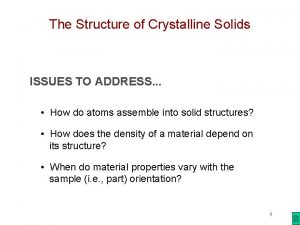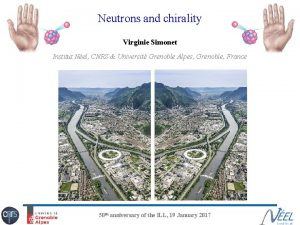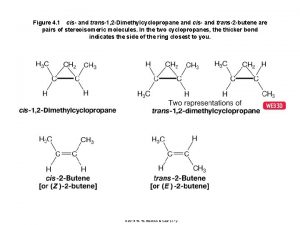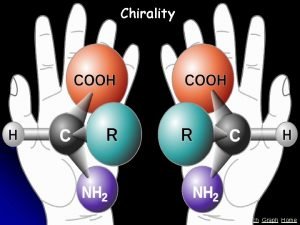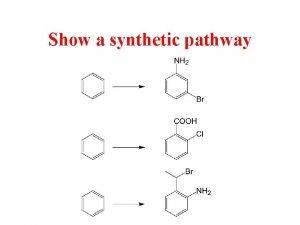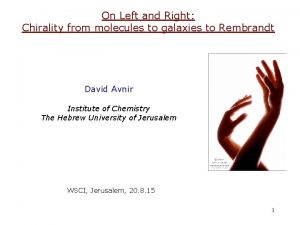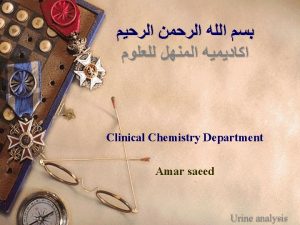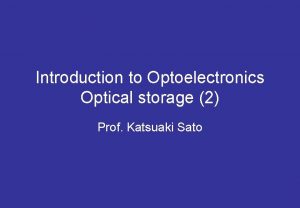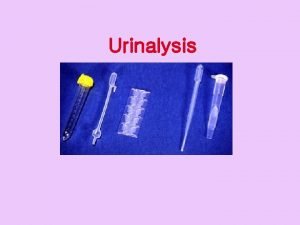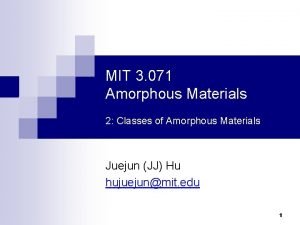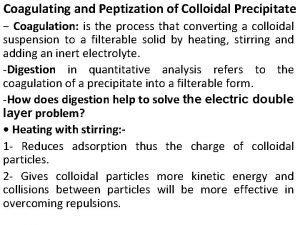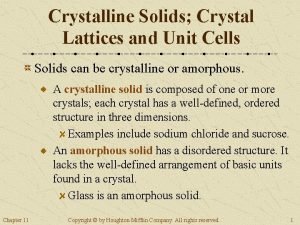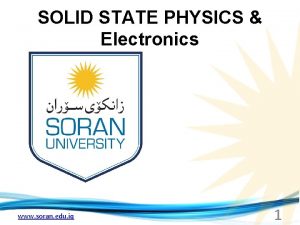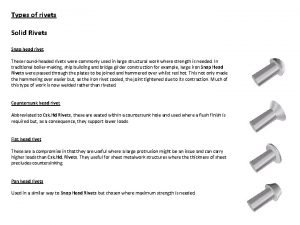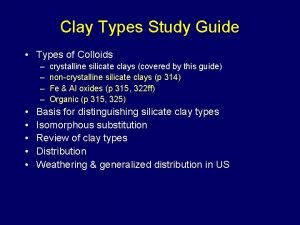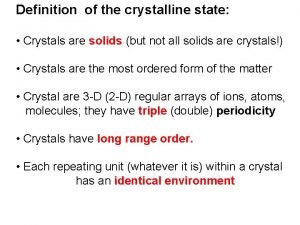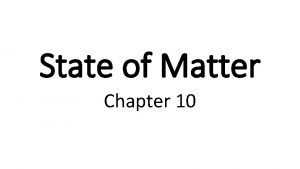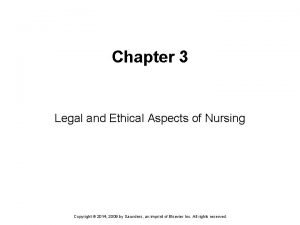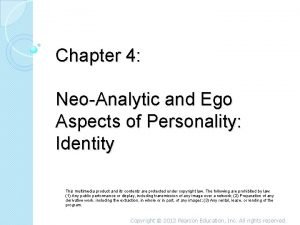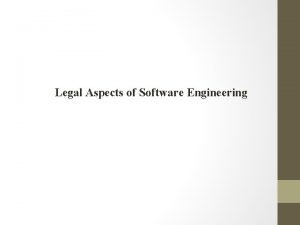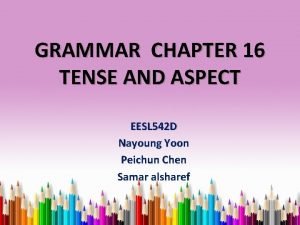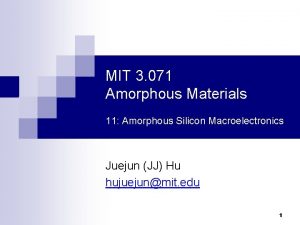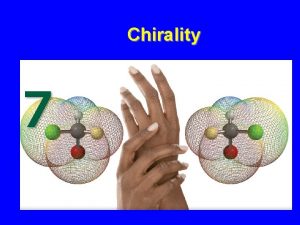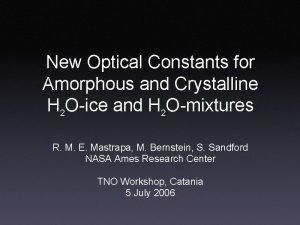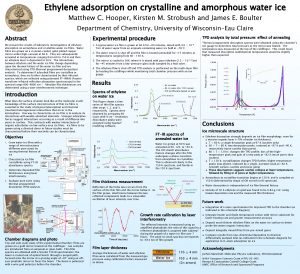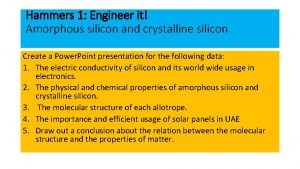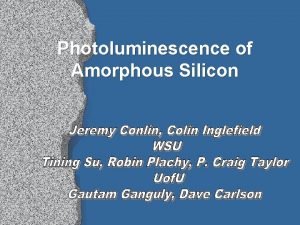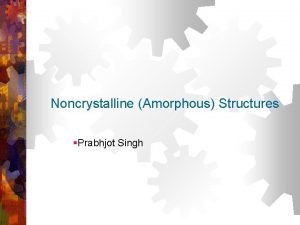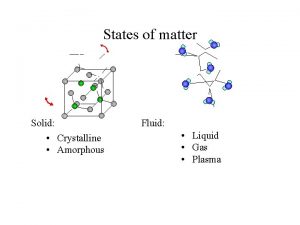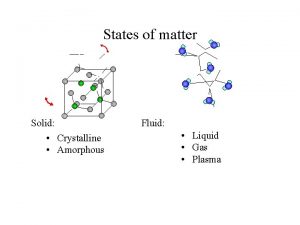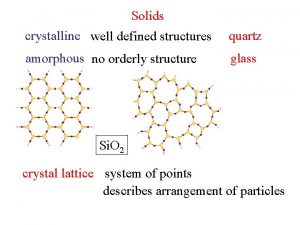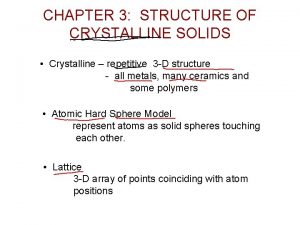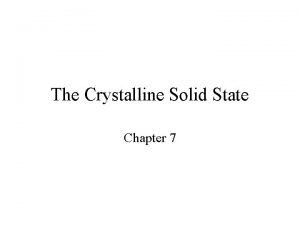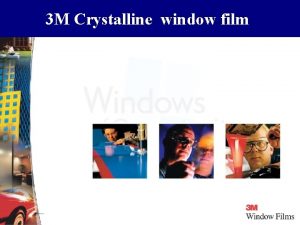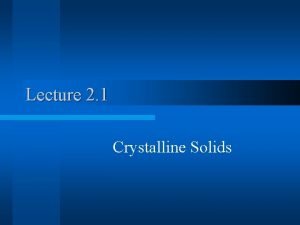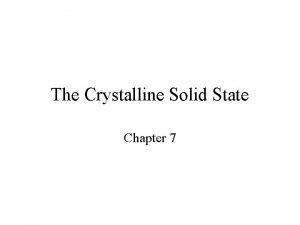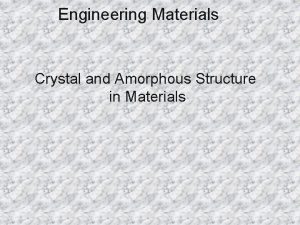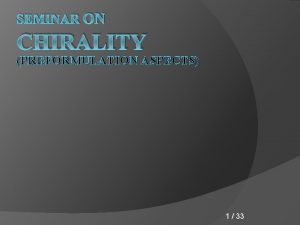Chirality in amorphous and crystalline materials experimental aspects








































![Scope: The dopants Small molecules, hydrophilic or hydrophobic: Sudan III Biologicals: D-Tryptophan Complexes: [Rh] Scope: The dopants Small molecules, hydrophilic or hydrophobic: Sudan III Biologicals: D-Tryptophan Complexes: [Rh]](https://slidetodoc.com/presentation_image/570d431b16dafa039b2c948c91de9fca/image-41.jpg)




























- Slides: 69

Chirality in amorphous and crystalline materials - experimental aspects David Avnir Institute of Chemistry, The Hebrew University Summer School on Chirality Mainz, August, 15 -17, 2011, sponsored by

Main general questions to be addressed: #How is it possible to induce chirality in a material? # How is it possible to extract chiral activity from a material? Our main road: Si. O 2 -based amorphous materials and crystalline metals

Amorphous silica

How is it possible to induce chirality in a material? The classical approach: Attach covalently a chiral molecule to the surface of the (porous) material Often, a silylating reaction

Photophysical Recognition of Chiral Surfaces The excited chiral surface: Silica derivatized with R- or S-BNP The quencher: DMP, R-Q or S-Q With E. Wellner M. Ottolenghi J. Am. Chem. Soc. , 111, 2001 (1989

Stern-Volmer quenching analysis For the R-surface (shown): S-Q/R-Q = 1. 3 For the S-surface: R-Q/S-Q = 1. 2 The S-quencher recognizes better the R-surface

The second, newer approach Dope the material with a chiral molecule

DOPING OF SILICA IS MADE POSSIBLE BY THE SOL-GEL POLYCONDENSATION Si(OCH 3)4 + H 2 O H+ or (Si. O OH- m. Hn)p (unbalanced) Variations on this theme: – the metals, semi-metals and their combinations – the hydrolizable substituent – the use of non-polymerizable substituents – organic co-polymerizations (Ormosils) – non-hydrolytic polymerizations + CH 3 OH

Organic functionalization by physical entrapment of molecules within sol-gel matrices Monomers, oligomers Sol Gel Xerogel monomer * Small molecules oligomer * Polymers sol-particle * Proteins entrapped molecule * Nanoparticles


Doping the material with a chiral molecule: # A chiral catalyst # A protein # A chiral surfactant

Entrapment of a chiral catalyst ee = 78% (BPPM) The advantages # Covalent bonding chemistry is not needed # Working with a hydrophobic catalyst in water # Recyclability With F. Gelman J. Blum J. Molec. Catal. , A: Chem. , 146, 123 (1999

Doping the material with a chiral surfactant (1 R, 2 S)-(-)-N-dodecyl-N -methylephedrinium bromide (DMB)

The experiment: Inducing Circular Dichroism in Congo-Red Within Silica Sol The chiral inducer: DMB The achiral probe: CR

The ICD spectra of co-entrapped CR-DMB in hydrophilic and hydrophobic silica sols CR-DMB in solution (blue line) and CR solution (red line) CR-DMB@SG sol (red line) and CR-DMB@OSG sol (blue line) Has the silica matrix become chiral? S. Fireman

Second experiment with doped surfactant: NMR detection of diastereomeric interactions within phenylated-silica sols and gels S-BINAP 1 R, 2 S-DMB The possible interactions: DMB/S-BINAP With S. Fireman S. Marx DMB/R-BINAP


spectrum of BINAP-DMB diastereomers: Looking inside the sol and the gel of silica 5. 99 5. 94 31 P-NMR S-BINAP In solution ppm 6. 1 6. 0 5. 9 5. 8 6. 00 5. 98 ppm R-BINAP S-BINAP interacts better with the chiral surfactant In the sol ppm 6. 1 6. 0 5. 9 5. 8 6. 146 6. 132 ppm In the gel ppm 6. 2 6. 1 6. 0 5. 9 5. 8

What have we seen so far? # Covalent attachment of a chiral molecule # Physical entrapment of a chiral dopant Is it possible to induce structural chirality in a material? Make a hole which is chiral imprint the material; make a chiral silicate skeleton Dickey, 50’s

General methodology for chiral imprinting of sol-gel based thin-films With S. Marx S. Fireman

Silica thin-film chiral imprinting Where is “Smart porosity” needed? for evaluating ee, for chiral separations, for selective sensing, for chiral catalysis

Two different cases: I. Selectivity towards an enantiomer of the imprinting molecule Propranolol TMOS PTMOS MTMOS The functional monomers Film thickness: 700 nm Chem. Mater. , 15, 3607 (2003)

The enantioselectivity adsorption experiment Imprinted films Immersed in solutions of R or S, for adsorption, and radio -assay; or: Adsorbed molecules are leached out Fluorescence measurement Fluorescence: (lex = 288 nm; lem= 335 nm) Radio ligand binding of 3 H-S-Propranolol

Enantioselectivity towards Propranolol enantiomers

Electrochemical detection of enantioselectivity and molecular selectivity in very thin silica films D-Dopa 70 nm films Current / m. A Current (m. A) L-Dopa

The more general case: Enantioselectivity towards enantiomers of non-imprinting molecules Why is that important? Because a small, recyclable chiral imprinting molecules can be used and reused S. Fireman S. Marx

Silica imprinted with aggregates of DMB Was capable of separating the enantiomer-pairs of: BINAP Propranolol Naproxen

General enantioselectivity in imprinted thin films Discrimination Ratio R R 20% phenylated silica, 270 nm J. Am. Chem. Soc. 127, 2650 (2005)

General enantioselectivity in granules: Comparison of two methods of inducing chirality R R S S R R Before extraction: Chiral dopant (DMB) After extraction: Chiral holes The recognition handedness changes!

Next: If an Si. O 2 material is made chiral by a foreign molecule which either remains there or not, then: #How are the building blocks of the material affected? #Is it possible that an Si. O 4 tetrahedron which is neighboring to the chiral event, becomes chiral itself? #Is it possible that the material becomes chiral deeper inside?

Nature has already provided an answer -Yes, it is possible! Quartz

31 Right Helix A: P 3121 & B: P 3221 Si. O 4 32 Left Helix

Silica is composed of randomly distorted Si. O 4 tetrahedra. Therefore: 1. Each of the chiral Si. O 4 tetrahedra is a single enantiomer event. # A statistically similar counter enantiomer maybe defined. 2. Silica is a racemic mixture of chiral Si. O 4 tetrahedra: # Half comprise a homochiral left-handed set, and half a right-handed set. # This is true for ANY handedness definition; but each definition will divide the set differently into two equal halves.

3. Induction of chirality by any of the methods, will enrich the chiral population of Si. O 4 tetrahedra with one type of handedness.

The ICD signal of CR adsorbed on DMB@silica Co-doping: CR/DMB@silica Reversal of the ICD signal indicates that the chiralityinducer is different in the two cases. CR adsorbed on DMB@silica The only possibility is chiral skeletal porosity induced by the doped DMB

Inducing chirality in metals

Motivation: Why should one dope metals with organic molecules? * Hybrid materials of metals and organics have been unknown * Most elements are metals * Metals are everywhere – any new methodology of affecting their properties is interesting * The library of organic compounds is huge; the number of metals is small * Placing a molecule in a sea of electrons may affect its properties; and the properties of the metal * Synergetic effects between the metal and the dopant may emerge

Synthetic methods: Reduction in the presence of the dopant Doping through metal synthesis Reducing aqueous solution Aggregation and Reduction Ag. NO 3 entrapment Ag metal Dopant Reducing agent 2 Ag. NO 3 + Na. H 2 PO 2 + H 2 O 2 Ag + Na. H 2 PO 3 + 2 HNO 3 Hanna Behar-Levy et al, Chem. Mater. , 14, 1736 (2002)

CR@Ag 1: 100 molar Ag Congo-Red

Scope: The metals Magnetic metal Coin metals Noble metals Alloys: Cu-Pd, Cu-Pt, Au-Ag
![Scope The dopants Small molecules hydrophilic or hydrophobic Sudan III Biologicals DTryptophan Complexes Rh Scope: The dopants Small molecules, hydrophilic or hydrophobic: Sudan III Biologicals: D-Tryptophan Complexes: [Rh]](https://slidetodoc.com/presentation_image/570d431b16dafa039b2c948c91de9fca/image-41.jpg)
Scope: The dopants Small molecules, hydrophilic or hydrophobic: Sudan III Biologicals: D-Tryptophan Complexes: [Rh] Inorganic compounds: H 3[P(Mo 3 O 10)4] Polymers, hydrophobic or hydrophilic: Polyacrylonitrile Proteins: Alkaline phosphatase Nanoparticles: Carbon nanofibers

The New Materials Nafion@Ag PSSA@Au CR@Co CR@Cu

Scope: The entrapment range 0. 2% (doped metals) - 10% by weight (hybrid materials) For instance for PSSA@Ag: Molar ratio - PSSA-monomer units : Ag = 1: 250 Weight ratio - 0. 42 carbon w/w% Atomic molar ratio - C : Ag = 1: 30

Hierarchical structure: PSSA@Ag H. Behar-Levy, G. Shter, G. Grader, Chem. Mater. , 16, 3197 (2004)


Rhodium-complex @silver Rhodium- First taken after a few seconds

Thionin@Ag compression Thionin@Ag - Powder DMSO Thionin@Ag - Coin No extraction with water, although water is a solvent of the dye

Adsorption of CR compared to entrapment Adsorption on commercial Ag 1% Adsorbed Adsorption on Ag Entrapment in Ag 1% 100% Doped

Thionin@Cu-Pt: Entrapment vs adsorption Starting solution: 6. 2 x 10 -4 M Y. Ben-Efraim Adsorption: 4% Supernatant after entrapment: 3. 5 x 10 -7 M

Dopant@metal - the picture of the entrapment * Aggregated crystallite metal system * Porous material * The dopant is tightly entrapped in narrow pores and cages * The molecules are entrapped intact * Adsorption and entrapment are different processes

Scope: Properties and functionalities *Affecting the metal properties - conductivity *Affecting the reactivity characteristics – “acidic metal” *Affecting the metal structure – chiral metals *Affecting the catalytic properties of the metal *Using a metal as a support for heterogeneous catalysis *Bioapplication: Synergism in antibacterial activity *Bioapplication: Enzyme entrapment within metals *Corrosion prevention *New concept in batteries

Chlorhexidine digluconate@Ag Thermal gravimetric analysis Racheli Ben-Knaz, Rami Pedahzur, Adv. Funct. Mater. , 20, 2324 (2010)

Enzymatic activity of acid-phospatase@gold Michaelis-Menten doseresponse kinetics is obeyed Km = 9. 3 m. M (free enzyme: 1. 25 m. M ) Racheli Ben-Knaz, Biomaterials, 30 126 (2009)

What is chiral doping doing to the metal? Is it inducing chirality in it?

Detection of chirality of metals using photoelectrons Sample: Chiral gold Electron beam Detector Laser source Circularly polarized 193 nm Vacuum chamber Photoelectrons are emitted from the conducting band with different kinetic energies. H. Behar-Levy, O. Neumann, Ron Naaman, Adv. Mater. 19, 1207 (2007)

Entrapped chiral molecules in gold or silver for the photoelectron experiment D- or L-Tryptophan L-Glutathione Quinine (R=COH 3)

Blank: Scattering from undoped Au

Scattering from gold doped with L-quinine

Two enantiomers of gold Reversal of scattering behavior by switching between the enantiomers of tryptophan Silver was made chiral too!

Chiral doping of palladium 1: (–)-Cinchonidine (CD) 2: (+)-Cinchonine (CN) L. Duran Pachon, I. Yosef, T. Markus, R. Naaman, D. Avnir, G. Rothenberg, Nature-Chemistry, 1, 160 (2009)

Pd SDS@Pd Clockwise irradiation, Counterclockwise, Linearly polarized

Photoelectron emission spectroscopy of chirally doped palladium CN@Pd CD@Pd

What is chiral in the metal? # The chiral dopant affects the metal molecular orbitals, distorting them chirally # The geometry of the metal pore around the doped molecule is chiral These are two different chiral entities!

Doping vs chiral imprinting with cinchonine CN@Pd Doped CN@Pd after extraction Imprinted Similar but mirror behavior with CD@Pd

Enantioselectove adsorption on CN-imprinted palladium Concentration in solution CD adsorption on dopant-free Pd CN adsorption on dopant-free Pd CD readsorption on CN imprinted Pd CN readsorption on CN imprinted Pd CD CN

Chiral catalysis in the context of metals

Level 1: The metal serves as a heterogenization matrix for a chiral catalyst L-glutamic dehydrogenase@Au α-ketogluterate + NH 4+ + NADPH L-Glu + NADP + +H 2 O

Level 2: A Catalytic metal is chirally doped Hydrogenation of isoprene Isophorone (R)-3, 3, 5 -Trimethyl-cyclohexanone L. Duran Pachon, I. Yosef, T. Markus, R. Naaman, D. Avnir, G. Rothenberg, Nature-Chemistry, 1, 160 (2009)

A Catalytic metal is chirally imprinted CN-imprinted Pd Motivation: Chiral catalysis with a pure metal A challenge to be met!
 Crystalline and non crystalline materials
Crystalline and non crystalline materials Chem
Chem Lattice basis
Lattice basis Crystalline solid and amorphous solid
Crystalline solid and amorphous solid Anisotropic
Anisotropic Absolute configuration
Absolute configuration Virginie simonet
Virginie simonet Cis-1 2-dichlorocyclopropane chiral
Cis-1 2-dichlorocyclopropane chiral Chirality
Chirality Chirality centers in sucralose
Chirality centers in sucralose Early man
Early man Crystalline solids
Crystalline solids Experimental vs non experimental
Experimental vs non experimental Descriptive studies
Descriptive studies Disadvantages of experimental research
Disadvantages of experimental research Non experimental design vs experimental
Non experimental design vs experimental Nonexperimental study
Nonexperimental study Urine microscopy
Urine microscopy Metal deficiency defect
Metal deficiency defect Shapeless formless vague
Shapeless formless vague Amorphous pronunciation
Amorphous pronunciation Amorphous disk mark
Amorphous disk mark Alkaptouria
Alkaptouria Mit
Mit What does hyaline casts in urine mean
What does hyaline casts in urine mean Mixed crystal formation in gravimetric analysis
Mixed crystal formation in gravimetric analysis Peptization
Peptization Difference between colloidal and crystalline precipitate
Difference between colloidal and crystalline precipitate Occlusion in gravimetric analysis
Occlusion in gravimetric analysis Crystalline substances
Crystalline substances Is fudge a crystalline candy
Is fudge a crystalline candy Polycrystalline solids
Polycrystalline solids Snap head rivet application
Snap head rivet application Crystalline silicate clays
Crystalline silicate clays Crystal state
Crystal state Crystalline solid
Crystalline solid Destiny 2 crystalline formations
Destiny 2 crystalline formations Crystalline solid
Crystalline solid Natural materials
Natural materials Example of useful and harmful materials at home
Example of useful and harmful materials at home Man made map
Man made map Adopting and adapting teaching materials
Adopting and adapting teaching materials Direct materials budget with multiple materials
Direct materials budget with multiple materials The visual and artistic aspects of presenting a product
The visual and artistic aspects of presenting a product Look at the photo. answer the questions with short answers
Look at the photo. answer the questions with short answers Chapter 2 legal and ethical aspects of nursing
Chapter 2 legal and ethical aspects of nursing Changing trends in hospital care
Changing trends in hospital care Discourse aspects of interlanguage
Discourse aspects of interlanguage Legal and ethical issues in information security
Legal and ethical issues in information security Human resource management by gary dessler 11th edition
Human resource management by gary dessler 11th edition Marketing and financial aspects
Marketing and financial aspects Intellectual and conscious aspects
Intellectual and conscious aspects Neoanalytic theory
Neoanalytic theory It encompasses several different aspects, including
It encompasses several different aspects, including 6 aspects of wellness
6 aspects of wellness Trade related aspects of intellectual property rights
Trade related aspects of intellectual property rights Palmer hayden jeunesse
Palmer hayden jeunesse 5 themes of geography project
5 themes of geography project All aspects of software production
All aspects of software production Alterations in various aspects of society over time...
Alterations in various aspects of society over time... Social aspects of interlanguage
Social aspects of interlanguage Cultural aspects
Cultural aspects Regression defense mechanism example
Regression defense mechanism example Legal aspects of catering premises
Legal aspects of catering premises Recurring aspects of designs are called design
Recurring aspects of designs are called design Features of romanticism
Features of romanticism Legal aspects of software engineering
Legal aspects of software engineering La structure du texte descriptif
La structure du texte descriptif Verb aspects
Verb aspects Quantitative aspects of chemical change grade 11
Quantitative aspects of chemical change grade 11
